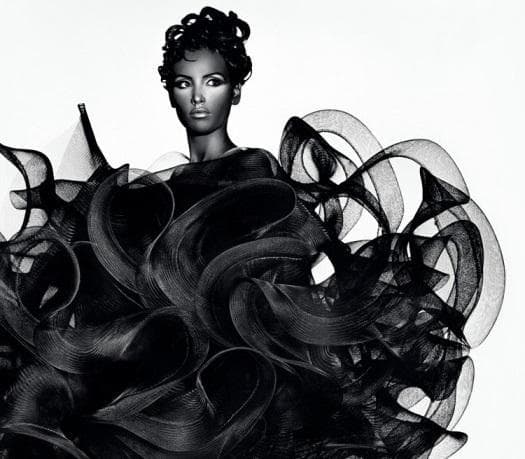Advertisement
Challenging The American Notion Of Beauty: Japanese Fashion At The Peabody Essex Museum
Resume
The influential Japanese fashion designer Yohji Yamamoto once said, "I think perfection is ugly. Perfection is a kind of order, which someone forces onto a thing. A free human being does not desire such things."
That unconventional philosophy is on full view at an exhibit called "Future Beauty: Avant-Garde Japanese Fashion," now at the Peabody Essex Museum in Salem.
It's a collection of about 100 dresses and other items of clothing designed by Yamamoto himself and some of his peers, like Issey Miyake and Rei Kawakubo. Unless you follow haute couture, you may not know those names. But they're all considered groundbreaking Japanese designers who shook up the fashion world in the 1980s and continue to influence clothing styles to this day.
As an example, dresses by western designers are often very va-va-voom. But some of Kawakubo's dresses look like shapeless shredded frocks, with flaps of material dangling from the torso. WBUR's Sacha Pfeiffer toured the collection with the museum's chief curator, Lynda Hartigan, and asked how those torn-up dresses were publicly received. (TRANSCRIPT BELOW)
More
Transcript
Lynda Hartigan: What the press went after was, indeed, that the clothing looked tattered, like it was bombed. Some people described them as rags. But I think we can look at, for example, Rei Kawakubo's black outfit that's got very heavily knit interwoven parts that looks like a big bulky sweater.
Sacha Pfeiffer: Billowing, almost.
And a very sort of layering kind of skirt that's still very narrow to the body. Basically, if we just think about all the bulky sweaters and the narrow leg profile that we're into today, it's a precursor of that sort of thing. But, indeed, at the time this clothing was really meant to question what is the relationship of clothing to a women's body in particular? We still are very much into form-fitting, bust-revealing, curvaceous kind of clothing, and the Japanese really just had a very different sense of how to structure clothing so that you had a different relationship to it.
It was much less form-fitting? Almost making your body more shapeless?
I don't think they considered it shapeless. I think what they were after as designers is about how things don't have to be so orderly and perfect. I mean, we have this sort of still Greek classical thing going on. So things can be asymmetrical and still make you look interesting. You can have space between your body and the cloth. Part of it is, indeed, about a culture's difference in perception of sexuality. You know, in the west this form-fitting, the tighter-the-better, the more attractive, the more sexualized. And the Japanese designers – especially the women designers like Rei Kawakubo – really went after that.
Questioning it?
In terms of you don't have to sexualize clothing in that way because many of the Japanese traditionally believe that the more you conceal the body, the more mysterious it is and therefore the more seductive it is. So it's still about sex appeal.
The other thing you notice visually, right where we are, is that these outfits are very drab. I mean, they're essentially either some shade of white or black.
Uh huh, and this was one of the Japanese innovations. So, at the time, in the early '80s the American and the western/European fashion world was really into bright color and patterns. And, instead, what the Japanese went to was to question the color palette, and they have emphasized ivory, white and black early on. We in the west actually don't read those as colors. We think they're shades or they're just not colors the way red or blue or green are. But, to them, black and white and ivory mean a great deal in their culture because of ink painting, when you think of all the fields of bare surfaces of ivory silk that the ink painting is done on. So it's just a different way of looking at color, and it's partly to just simply say that those simple very direct colors have incredible power
Some people do wear these — primary celebrities and runway models — but this looks to me almost totally impractical unless you're trying to make an extreme fashion statement.
And let's face it: the fashion industry loves to make extreme fashion statements! I mean, when we look at this black Yamamoto evening gown, you could make an incredibly dramatic entrance in this. I mean, the skirt really sticks out.
It's like a petticoat.
There are big curves of the black fabric and then this huge cowl collar and the organza up around her neck and then the flowing of the coat down on the floor.
It's like the mannequin is swathed in fabric.
Absolutely. Part of this is also a reference to western fashion because the Japanese were also very attentive to western fashion traditionally, so it's not completely about dissing what has come before or from another culture; it's really in the end the fusion of east meets west.
There is, on the other side of the gallery, more traditional, somewhat western-looking clothing, at least some brighter colors. Could we walk over there?
Oh, sure, absolutely. Before we move on to other parts of the show, we're looking at a piece by the designer [Koji] Tatsuno, and let's see how can I describe this: somewhere between a Brillo pad and smoke swirling around the figure. I mean, this is just bundles and bundles of cloth that has wire in it and the cloth itself is transparent, so she looks like she's totally enveloped in waves of clothing from head to about knee length.
Like she's wearing a bow, a Christmas bow.
She looks very wrapped, but in an extraordinarily exuberant way. I keep thinking of Marilyn [Monroe] on the grate – you know, with the dress coming up? It has that kind of look. But it's in a beautiful beige-gold-bronze kind of tone, and it's extraordinarily fanciful. I couldn't possibly imagine sitting in the darn thing. But it's just an extraordinary example of what Japanese have been able to do with materials, because one of their big innovations has been working with textile designers and industrial desingers to create new fabrics that can be worked and shaped in different ways, and that is obviously a huge accomplishment in this instance.
Are these designers also trying to challenge our stereotype of beauty?
Yes, absolutely, and that's partly why the show is called "Future Beauty." This notion of designing for the future, designing things that no one has seen before has been a big motivation for them. But culturally and over time different people have had different definitions of beauty. And in the west we still tend to associate beauty with women and with a highly sexualized form-sitting perfection, even like our facial features have to be symmetrical. Everybody got upset when Lauren Hutton had a gap tooth, for God's sakes. So it's that definition of beauty in terms of perfection, and with the Japanese they actually value imperfection – a sense of the worn, the aging and that sort of thing. Although Lord knows there's a huge emphasis on youth culture in Japan, as well, and that's part of our the also.
There's a cluster of male mannequins here in crazy colors. One basically has an Italian tablecloth short and one has this houndstooth black and white…
Ah, so interesting. You read those as male mannequins. Those are women. So let's walk over and talk about them. So these are three ensembles by Rei Kawakubo, and they're all women now that you can see the faces on the mannequins. They're from a collection that she named "Clothes Meets the Body, Body Meets the Clothes," otherwise nicknamed the "lumps and bumps collection."
Because they look humpbacked?
Yes. So if you can imagine on the radio someone wearing a long skirt that's kind of ankle length and then suddenly there's a huge poof over your stomach and then down your thighs – the very areas, of course, that we try strenuously not to over-emphasize — and then big padding that's not just shoulder pads that we used to have from the 1980s, but literally on your back or on top of your shoulders in massive ways that make you look like you're misshapen. That goes to that whole notion of what's beautiful and what's right.
They look like shoulder pads that have slipped out of place or been put in the wrong place.
Or gone nuts in terms of lots and lots of stuffing! But, nonetheless, what Kawakubo is trying to do is just say what parts of the body do you want to emphasize? What's your comfort level?
Some of these fabrics are a stretch to even call fabrics. There's shredded newspaper and feathers and one looks like air bubble insulation packing.
Yes. I think this is one of the reasons why you can also look at these fashion designers as artists — because they really have tested the boundaries of materials. So there are dresses here made out of the celluloid used for film. There's one dress composed of shredded invitations that the designer had in his archives. Others represent parachute material, as well as just extraordinary uses of polyester. As far as I'm concerned, polyester has never looked so good as it looks in this exhibition!
Lynda, usually museums are places where you can look but don't touch, but there's a try-on section here of some of the outfits.
Yes, we have a dressing room! We went on eBay and bought some clothing by Miyake and Kawakubo and Yamamoto, and so we've got about eight or nine garments for people to try on — men's and women's, so the guys have a chance, as well. Some of it's very form-fitting and some of it's not. And some, like the Miyake red stoll that we have, is just this huge piece of cloth and then you can tie it in all sorts of different ways to create pants or a skirt or a shawl or a dress or a toga. So it gives you the sense of what the flexibility of the clothing is.
Could I try this one on?
Absolutely!
How often can you try on a high-end Japanese designer outfit?
Go right ahead!
It's a little like a shawl.
It can be.
There's a neck opening.
There's a hole and you can interpret that as for your arm or for your head or possibly for your leg.
Or just a giant scarf, right?
Yes, yes.
It feels very beautiful.
Oh, it's beautiful.
It feels very feminine, if there's a feminine feel.
Yes, absolutely, and the color's extraordinarily striking — vivid red. But it's not silk. People might look at it and think that it's something like that, but it's total polyester.
Polyester? Really? So you're right about polyester!
Yes, polyester can be more than those leisure suits!
Is there anything in this gallery that you really wish were in your bedroom closet?
Anything? How about many things! Don't put me in that position! I would love to try on the dress that we talked about a little earlier – the thing that looks like the poof and the smoke and the swirl. And I love the dress with the pointy elements made out of film. There's just a kind of playfulness here that I just find very engaging. I'd even try on one of the lumps and bumps dresses to see what that would do for me or not. I think it's also this line between do you want to wear it or do you want to own it? Because you can collect it — and then, yes, I'd like to have everything in the show for my collection!
Thank you very much for tour.
Oh, you're welcome.
This segment aired on November 29, 2013.
